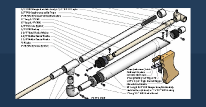Goal: Make the simplest SNAP possible with things I can get from Home Depot. I didn't want to make any overly-custom parts. I wanted to learn about making effective plungers and reproducible methods of construction.
The plunger:
I used a piece of 3/4" PVC for the plunger rod because 3/4" fittings fit near-perfectly inside 1 1/4". I first tried a neoprene washer for my plunger. I couldn't get one the right size and ended up cutting one down, but that just caused uneven edges. There was also too much friction to make it viable. (I need to go back and try this again now that I have white lithium grease, vaseline didn't work for beans). I ended up using the method of sandwiching an o-ring with pieces of pvc and using electrical tape to get the right diameter. This ended up working well. The draw is exactly 6".
The catch:
I simply used a another fitting in order to get the edge I needed for the catch. I don't need a ramp because my trigger pin is rounded (more later)

The trigger:
I used a clothespin trigger because it seems to be the simplest, fool-proof option. Instead of a nail, I used a shelf peg because it is rounded on one side, and flat on the other; Perfect for letting the plunger move smoothly one direction, and catch in the other. It was difficult getting such a large hole drilled in a clothespin, and the force of pressure-fitting the peg caused it to crack. I reinforced it with thread and hot glue, which has been holding. On my second attempt, I drilled the hole slightly too big, and put hot glue in the hole before inserting the peg. This seems to hold much much better (plus no splitting)


The Barrel:
The barrel is a reduction from 1 1/4" PVC down to 1/2" CPVC. The CPVC couple pressure fit nicely inside the 1/2" reducer.

The spring:
Unfortunately, the only viable option at my Home Depot was an extension spring. This is obviously not a good option considering the dead-space and constant impacts deforming the spring. It was also a struggle to get around an eye-bolt. I used an 18lb spring from this.

Final product:


Summary:
Tools used: Drill, Dremel, PVC cutter.
Relative difficulty: 0.5. The only reason this isn't a zero is because I had to use the dremel to make a big enough hole in the end cap for the 3/4" plunger rod to move through. I only had to glue 1 part because it had a loose fit. I didn't bother figuring out a handle or proper trigger because this is honestly a throw-away piece.
Range: ~35 ft flat. Nothing to write home about.
Cost: Obviously for certain parts, I had to buy extra. From nothing I'd say it was less than 20 dollars. (more expensive for me since I bought a drill and a dremel
What I learned: O-rings were a simpler, easier method for getting a good seal on the plunger than a neoprene washer. (I probably did it wrong the first time, though). PVC plunger rods are heavy, and cause a lot of power loss. Shelf pegs worked awesome for the trigger, it's very smooth.
I've already made a smaller, better version which I'll do a write-up on next.
Edited by M4573R, 28 April 2012 - 04:59 PM.













